|
|
W.A. RASIC's
|
| NORTH REACH
PERRIS VALLEY PIPELINE PROJECT |
In September of 2007 W.A. RASIC construction company out of
Bell
Gardens California, began working on what would be one of there biggest
projects to date. 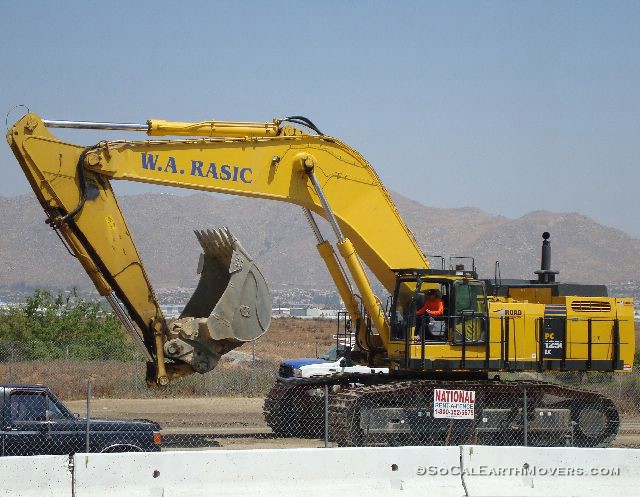 The Project is known as the "North Reach Perris Valley
Pipeline"
and is located just east of the 215 freeway in Riverside. The
Metropolitan Water District (MWD) has been needing a new pipeline to
feed the growing Perris and Riverside areas, and once completed this
pipeline is scheduled to deliver an additional 150 million gallons of
water per
day. With a labor and equipment cost alone of $39.3 million
dollars and length of just over 2.5
miles (of almost all solid rock), not too many contractors were willing
to attempt this task, but W.A. RASIC was the winning bidder.
The Project is known as the "North Reach Perris Valley
Pipeline"
and is located just east of the 215 freeway in Riverside. The
Metropolitan Water District (MWD) has been needing a new pipeline to
feed the growing Perris and Riverside areas, and once completed this
pipeline is scheduled to deliver an additional 150 million gallons of
water per
day. With a labor and equipment cost alone of $39.3 million
dollars and length of just over 2.5
miles (of almost all solid rock), not too many contractors were willing
to attempt this task, but W.A. RASIC was the winning bidder.
The Pipeline starts at MWD's
Henry J. Mills
water treatment plant at the top of Alessandro Blvd. and travels west
down Alessandro to just before the 215 freeway. Once by the
215
it parallels the freeway for a little over half a mile down to Cactus
street. This will be the where the north reach section ends. W.A. RASIC
company will be heading all the construction while Butier Construction
Management will be working with the MWD and watching over progress of
the pipeline to make sure deadlines are being met.
Because
of the massive scale of this project, and the depths they are digging,
as well the material they have to dig through, not to mention weight of
each pipe
segment they are laying, RASIC purchased multiple pieces of
heavy
equipment just for this project. Some of the large excavators
being used are 2 brand new CATERPILLAR 385C L excavators, 1 brand new
CATERPILLAR 365C L excavator, a HITACHI EX1200 excavator, a
HITACHI EX800 excavator, a HITACHI EX750 excavator, 2 JOHN DEERE 450CLC
excavators, a KOMATSU PC1000 excavator, and a KOMATSU PC1250-8
excavator. Wes Brodeur, Project manager for W.A. Rasic on this project,
said the KOMATSU PC1250-8 (Pictured
above)
was purchased from the dealer and brought in on six trucks and then
assembled on site. The newest addition to the site he noted
was
the HITACHI EX1200 excavator, this 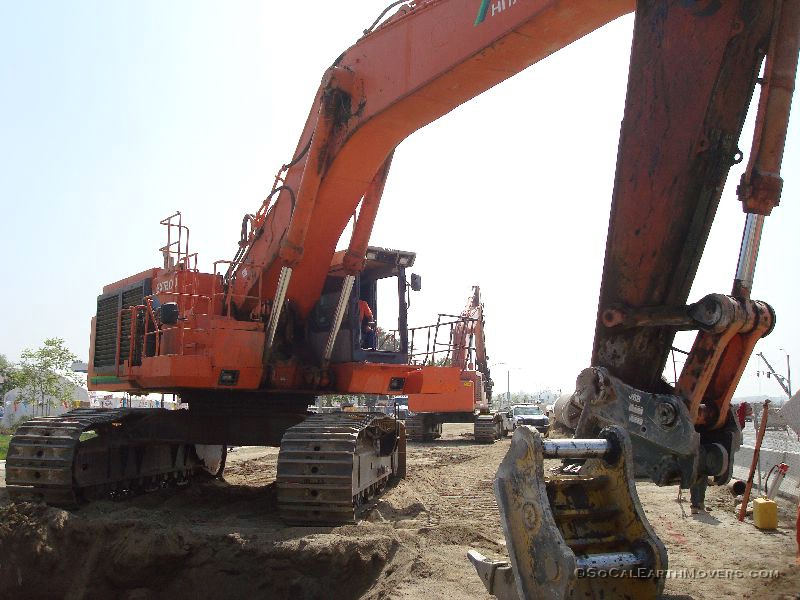 machine
was purchased used (with very low hours), and brought over
from
the
east coast to finish up the third of three different pipe
headings. Wes said that these are the largest
machines
available to the construction industry, anything bigger is
considered mining equipment. All
the excavators on site have been fitted with quick couplers
to
make
switching attachments much faster and easier Brodeur also
mentioned. (Like
the HITACHI EX1200 excavator shown in this picture on the
left disconnecting its ripper tooth attachment)
Other large pieces of machinery on site include; a new
CATERPILLAR 980H
loader, new CATERPILLAR 972H loader, and a new JOHN DEERE
400D
rock truck. machine
was purchased used (with very low hours), and brought over
from
the
east coast to finish up the third of three different pipe
headings. Wes said that these are the largest
machines
available to the construction industry, anything bigger is
considered mining equipment. All
the excavators on site have been fitted with quick couplers
to
make
switching attachments much faster and easier Brodeur also
mentioned. (Like
the HITACHI EX1200 excavator shown in this picture on the
left disconnecting its ripper tooth attachment)
Other large pieces of machinery on site include; a new
CATERPILLAR 980H
loader, new CATERPILLAR 972H loader, and a new JOHN DEERE
400D
rock truck.
Even with all this heavy machinery to
tear up the
earth, the pipe's path needed an extra bit of preparation before
excavation could begin. Wes described they used a method
called,
fifteen-inch-rock-perforation, or "FIRP" for short. This process makes
the hard rock they have to dig through like swiss cheese. To
do
this, large 15 inch "relief" holes were drilled into the rock to make
excavation easier. 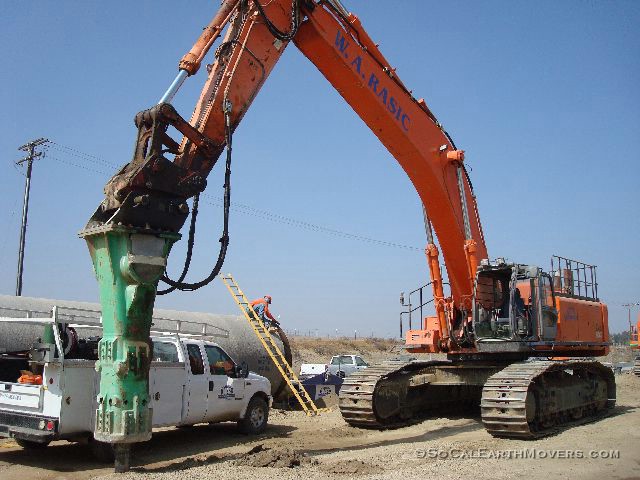 Even with these
relief
holes large
hammers, like the one pictured on
this Hitachi EX800 excavator on the right, are still being used to
break up the solid rock. Wes said that the rock they are facing is some
of the world's hardest rock, blue granite. This rock has a strength of
over 20,000 PSI. The hammer proven to be the best workhorse
on
site is a new 15 ton BTI
breaker they purchased. (shown in
this picture below attached
to a HITACHI EX750 excavator)
In other areas Even with these
relief
holes large
hammers, like the one pictured on
this Hitachi EX800 excavator on the right, are still being used to
break up the solid rock. Wes said that the rock they are facing is some
of the world's hardest rock, blue granite. This rock has a strength of
over 20,000 PSI. The hammer proven to be the best workhorse
on
site is a new 15 ton BTI
breaker they purchased. (shown in
this picture below attached
to a HITACHI EX750 excavator)
In other areas
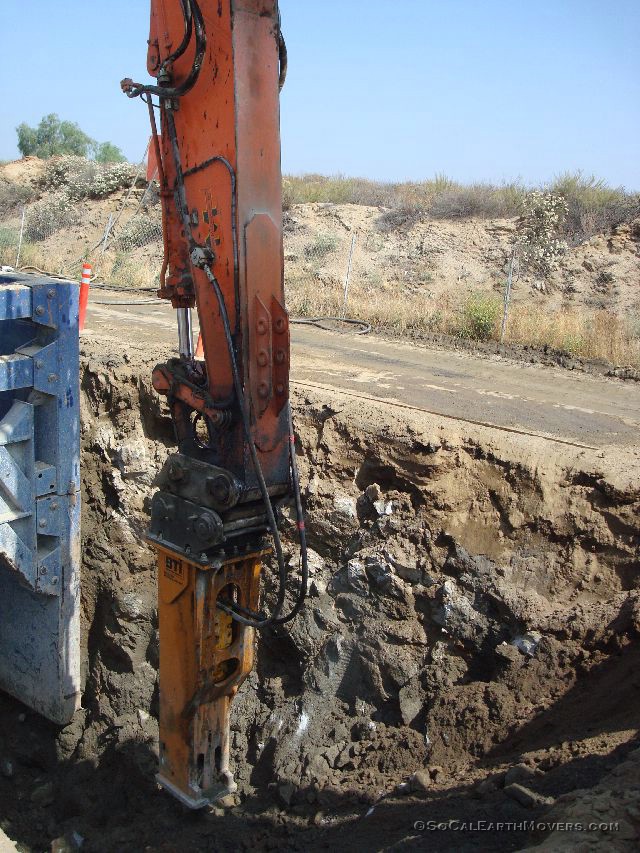 where
the material is softer and breakers
aren't needed
large teeth or "rippers" are being used by the
machines to tear
up the ground. Below is a close-up of the dual
ripper
attachment being where
the material is softer and breakers
aren't needed
large teeth or "rippers" are being used by the
machines to tear
up the ground. Below is a close-up of the dual
ripper
attachment being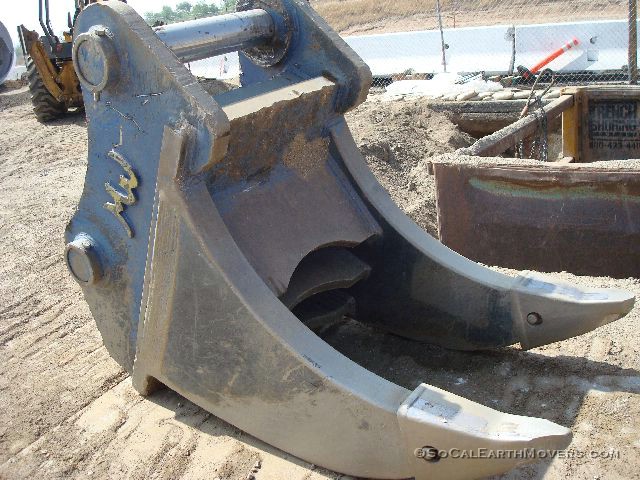 used by the
Komatsu PC1250-8 excavator.
The
average depth of this pipeline is between 20 and 30
feet
deep. To safely and affectively get the
job done
W.A. RASIC created HUGE trench boxes to shore up the holes
being
dug. These HUGE trench boxes are 45 feet long and weigh in at
56,000 lbs each. Due to the depth of the pipeline and the
long
segments of pipe these special high clearance trench boxes were the
only solution. Two different sections are used, first they
put a
45' long by 10' box into the trench and then they place an additional
45' long by 8' box on top of that one, these two sections are bolted
together creating one incredibly large used by the
Komatsu PC1250-8 excavator.
The
average depth of this pipeline is between 20 and 30
feet
deep. To safely and affectively get the
job done
W.A. RASIC created HUGE trench boxes to shore up the holes
being
dug. These HUGE trench boxes are 45 feet long and weigh in at
56,000 lbs each. Due to the depth of the pipeline and the
long
segments of pipe these special high clearance trench boxes were the
only solution. Two different sections are used, first they
put a
45' long by 10' box into the trench and then they place an additional
45' long by 8' box on top of that one, these two sections are bolted
together creating one incredibly large 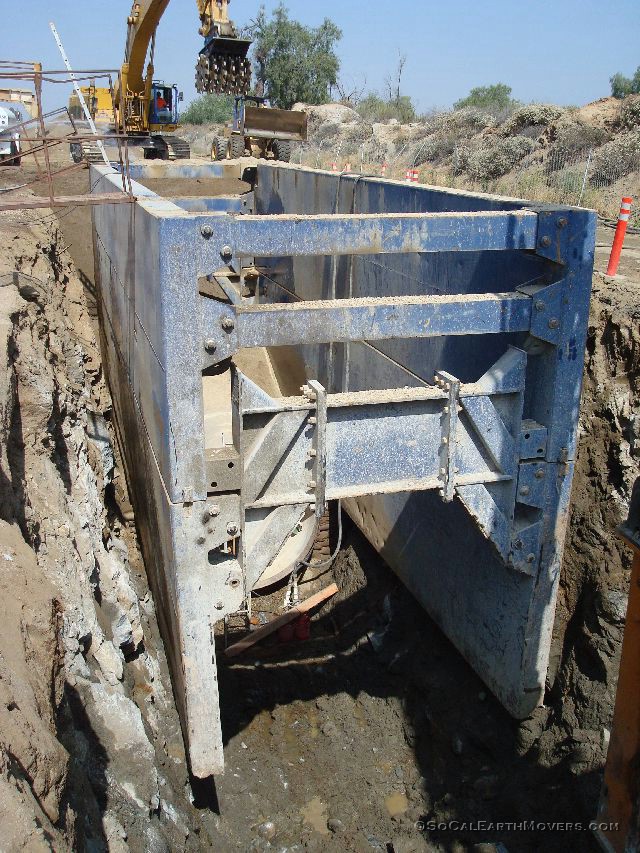 trench shield. As the pipe progresses forward these
mammoth
boxes are dragged forward in the trench as well by the large
excavators. A total of 3 of the huge 45' stacked trench boxes
are
on site. ( Pictured
on
the left is one of the 3 trench boxes on site, this
one at heading one. )
trench shield. As the pipe progresses forward these
mammoth
boxes are dragged forward in the trench as well by the large
excavators. A total of 3 of the huge 45' stacked trench boxes
are
on site. ( Pictured
on
the left is one of the 3 trench boxes on site, this
one at heading one. )
To keep construction moving at a fast pace RASIC
actually
has the pipeline being laid in 3 different areas, known as
headings, at once. Three different crews are all
working at
once in different areas of the site, each is digging and
breaking
through hard rock to create the needed trench, and then
laying a
segment of pipe once enough trench has been dug to fit one of
the
40' long pipe segments. Project Manager Brodeur said with
these
three crews working on different headings at once they lay an
average of 120 feet of pipe a day, as long as they are not
hitting too much rock. Each heading crew has its own
pieces
of machinery for getting the job done. Heading crew one had
the
KOMATSU PC1000, CAT 385C L, and HITACHI EX750. Heading crew 2 had the
KOMATSU PC1250-8 and CAT 365C L excavator. Heading crew 3 was
using the HITACHI EX1200 and EX800. The machines bounce around site
between headings and are used wherever needed most.
( Below right
pic shows the KOMATSU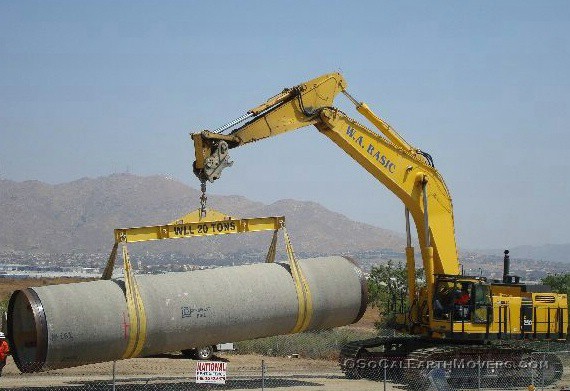 PC1250-8 bringing over a new
segment of 40' long pipe to lay into the trench
)
PC1250-8 bringing over a new
segment of 40' long pipe to lay into the trench
)
The pipe (supplied by MWD) being laid
on this
project is called CMLC (Concrete Mortar Lined Coated steel pipe).
This is a heavy duty steel pipe lined with concrete on the
outside. The pipe starting from the Henry J. Mills treatment plant is
108" wide and 40' long. As it travels down Alessandro the pipe narrows
down to 97" wide by 40' long. Each of these huge pipe segments weighs
an amazing 33,000 lbs explained Brodeur. Some of the
excavators on site weigh in around 120 tons and extra counter weight
still had to be added to aid for when lowering these massive pipe
segments into the trench. ( Below
left shows the rear of the HITACHI EX1200 excavator and how
additional counter weight has been added
)
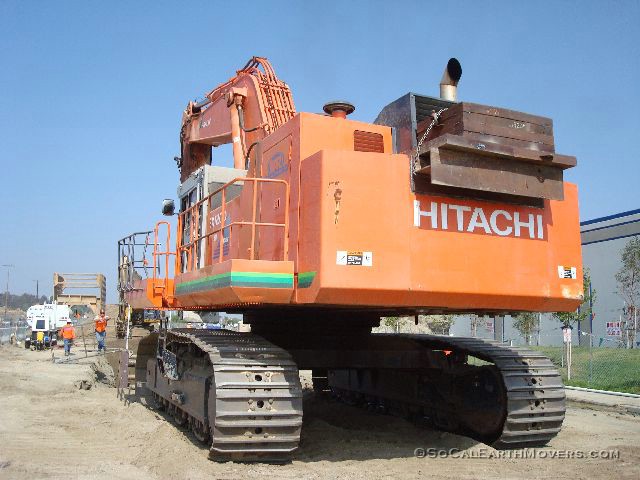 After each pipe has been put into the trench a special
backfill called "birdseye" is placed around the
pipe.
After the birdseye the trench is backfilled and
compacted
with screened earth. W.A. RASIC even has their own
screening facility on site. All the dirt dug from
the
trenches is loaded into dump trucks and hauled down
the street to
a large lot by the 215 freeway where it is screened
and then
reloaded into trucks to be used for backfill.
Wes said that
the soil they are screening here is so fine and
good for backfill
that they are actually selling it off to some of their
company's other
job sites. (below
right
is a photo of W.A. RASICS on site screening facility)
After each pipe has been put into the trench a special
backfill called "birdseye" is placed around the
pipe.
After the birdseye the trench is backfilled and
compacted
with screened earth. W.A. RASIC even has their own
screening facility on site. All the dirt dug from
the
trenches is loaded into dump trucks and hauled down
the street to
a large lot by the 215 freeway where it is screened
and then
reloaded into trucks to be used for backfill.
Wes said that
the soil they are screening here is so fine and
good for backfill
that they are actually selling it off to some of their
company's other
job sites. (below
right
is a photo of W.A. RASICS on site screening facility)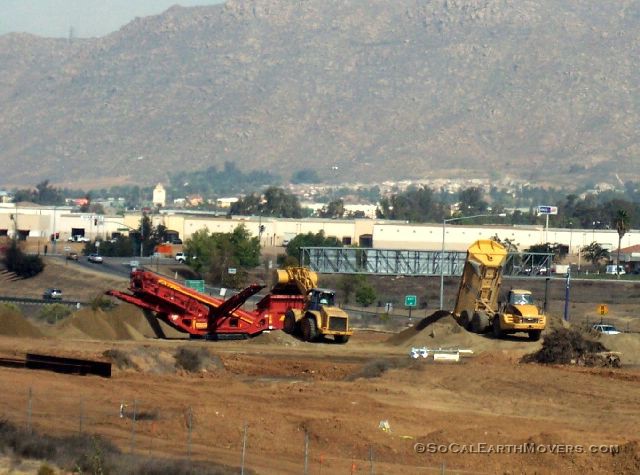 Ground water is always a factor when deep
trenching
and this site is no exception. The ground water flows
pretty heavily is some areas of this site. RASIC
has installed several pumps that pump out the ground water.
The
pumps then send the water through de-silting chambers before
releasing it.
Ground water is always a factor when deep
trenching
and this site is no exception. The ground water flows
pretty heavily is some areas of this site. RASIC
has installed several pumps that pump out the ground water.
The
pumps then send the water through de-silting chambers before
releasing it.
The
majority of this pipeline is being dug and laid by
excavators,
but in some areas hidden underground work is taking
place.
Once the pipe reaches the bottom of Alassandro
Blvd. it
will actually tunnel beneath the roadway. W.A. RASIC came in
and
dug a huge 60 foot deep access pit (through solid rock) on
the
opposite side of Alessandro and then contracted FoxFire constructors
inc. to tunnel some 400' diagonally beneath the road and then tunnel
another 400' east under the active in service train tracks that lie in
the pipes path. Wes described that tunneling beneath the road
and
tracks was part of the contract with MWD. It's a slow process
but
luckily we are allowed to use blasting to create these tunnels. On the
rest of the pipeline blasting is prohibited because of the close
proximity to other active underground utilities. (Below
left shows a picture of the access pit, notice the still active 60" RCP
storm drain pipe RASIC had to work around and then fasten to the
concrete wall they created)
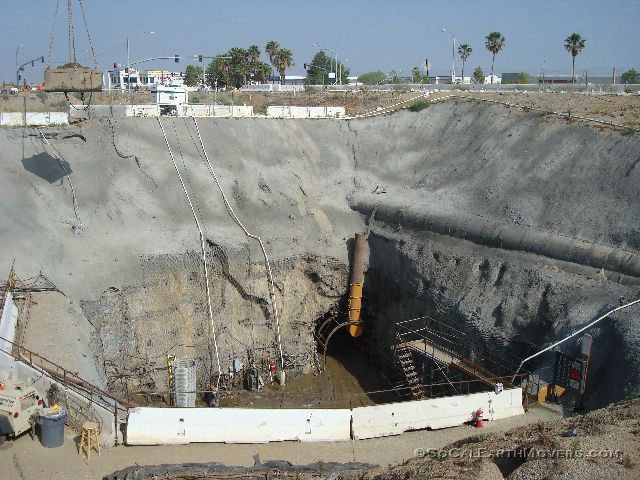
From within the access pit FoxFire is
working
on both the northwestern tunnel that goes beneath
Alessandro Blvd. and the eastern tunnel that will go beneath
the
active train tracks at once. First crews come in
and drill
holes for the blasting charges. They then set of
the
charges blasting the solid granite rock. Then the next crew
comes
in with a special lowloader to remove the rock and muck. The
lowloader hauls the rock and muck out of the tunnel to an
awaiting bucket attached to a crane above, once the
loader
fills the bucket it is hauled out of the pit. The two crews
work in tandem, one is in one tunnel drilling and
blasting
while the other is in the other tunnel clearing out the
materials. Once complete they switch tunnels and continue the
process until the tunnels are completed. Currently the tunnels are at
about 120' in each direction. ( The
top left picture below shows Wes Brodeur walking into the eastern
tunnel. The top right photo is from within the eastern tunnel looking
outwards, the pipe above is pumping in fresh air. The bottom left photo
is a picture of FireFox's special lowloader. The bottom right picture
is a shot of the lowloader filling the haul box with rock and muck.)
 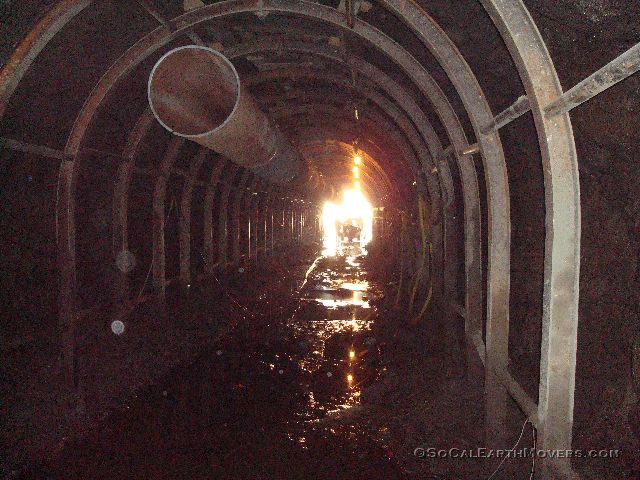
|
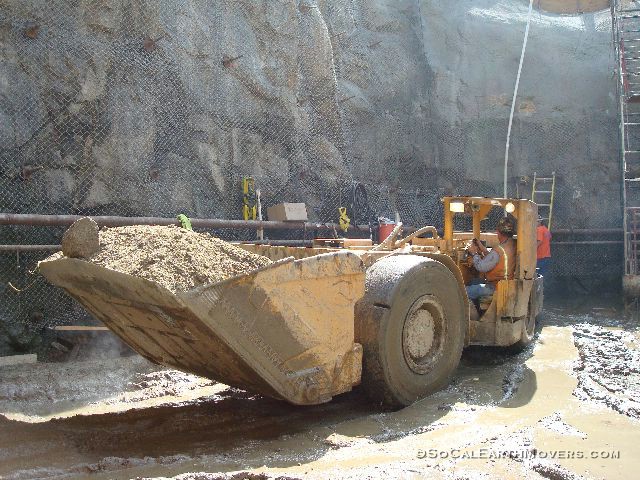 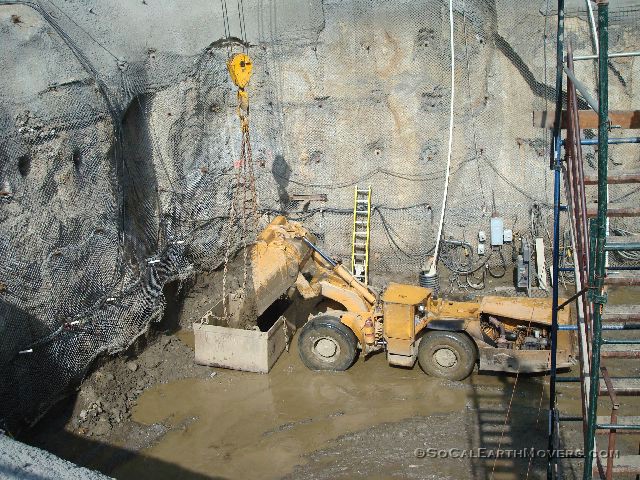 The tunnels are progressing at an average rate of
6 feet
per day said Wes. As they blast and haul out the muck they
support the tunnel by adding steel frame structuring (shown in the top right
picture
above)
and in soft areas line the structuring with wood to prevent the tunnel
from caving in. Wes also noted that they decided to do a small tunnel
at the top of Alessandro Blvd. just before the Mills plant, to go
beneath a set of high voltage overhead power lines and some passing
underground utilities. This was not initially in the plans but they
thought it was much safer route. Once the tunnels are complete
the
97" pipe segments will be lowered into the access pit and then inserted
into the tunnels. Once all segments are in the tunnels a special
concrete mixture will be pumped around the pipes to seal them down into
the rock.
The tunnels are progressing at an average rate of
6 feet
per day said Wes. As they blast and haul out the muck they
support the tunnel by adding steel frame structuring (shown in the top right
picture
above)
and in soft areas line the structuring with wood to prevent the tunnel
from caving in. Wes also noted that they decided to do a small tunnel
at the top of Alessandro Blvd. just before the Mills plant, to go
beneath a set of high voltage overhead power lines and some passing
underground utilities. This was not initially in the plans but they
thought it was much safer route. Once the tunnels are complete
the
97" pipe segments will be lowered into the access pit and then inserted
into the tunnels. Once all segments are in the tunnels a special
concrete mixture will be pumped around the pipes to seal them down into
the rock.
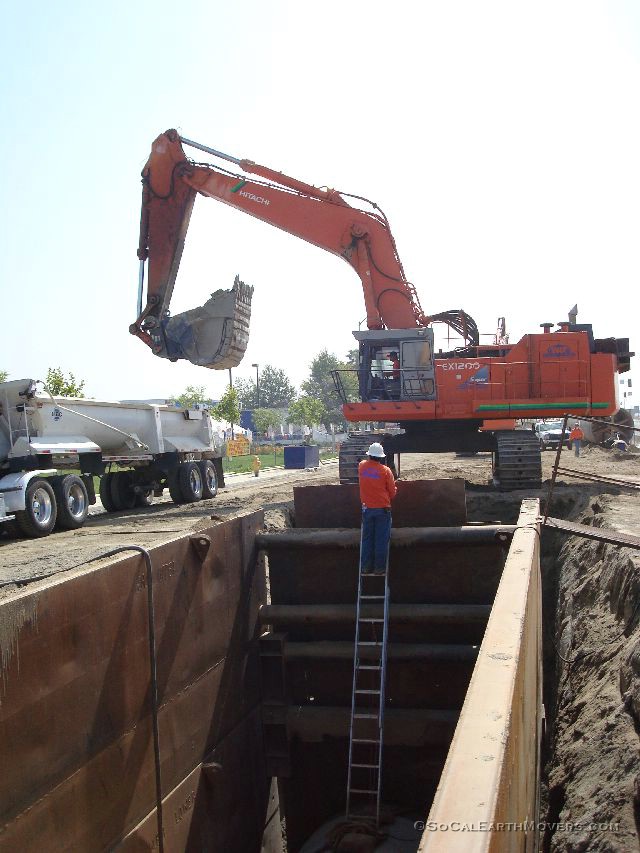 The tunnels will be one of the last things to
finish
up this pipeline. The above ground excavation is
nearing
completion and should be finished up by the end of the month
Brodeur said. Crews have worked 10 hour days and as
well as
every other Saturday throughout the pipelines construction,
and
lately even some nights. Last week crews closed a small
street
and worked throughout the night, two days in a row,
to put in a segment of pipe before morning.
The
MWD wants to have the pipe pressure tested and have
water
flowering by mid July. Because the MWD changed the
pipes
route and last minute and major amounts of unforeseen rock
was
hit, Brodeur says this is an unreal expectation
from
them. RASIC faces a $10,000 a day fine for each day
the
water is not flowing after the deadline.
The tunnels will be one of the last things to
finish
up this pipeline. The above ground excavation is
nearing
completion and should be finished up by the end of the month
Brodeur said. Crews have worked 10 hour days and as
well as
every other Saturday throughout the pipelines construction,
and
lately even some nights. Last week crews closed a small
street
and worked throughout the night, two days in a row,
to put in a segment of pipe before morning.
The
MWD wants to have the pipe pressure tested and have
water
flowering by mid July. Because the MWD changed the
pipes
route and last minute and major amounts of unforeseen rock
was
hit, Brodeur says this is an unreal expectation
from
them. RASIC faces a $10,000 a day fine for each day
the
water is not flowing after the deadline.
(left
pic
shows crews working
on heading 3 nearing the end of Alessandro blvd. where the
tunnel
will meet up with the trench)
(
Below a CAT 365C L excavator
backfilling other end of heading 3 where the pipe segment has
already been placed and welded)
After completed and water is flowing, W.A.
RASIC
will then finish up the project by fixing all the roadways,
traffic signals, medians, sidewalks etc. affected by construction.
In order to lay this pipeline RASIC had to do some major
temporary traffic control. Wes told how this
was a
major feat in itself. Alessandro Blvd.
had to
be widened from 3 lanes to 4 lanes on the eastbound side
and then divided in half, 2 lanes on each side. All the westbound
traffic was moved onto the newly added eastbound lanes so that the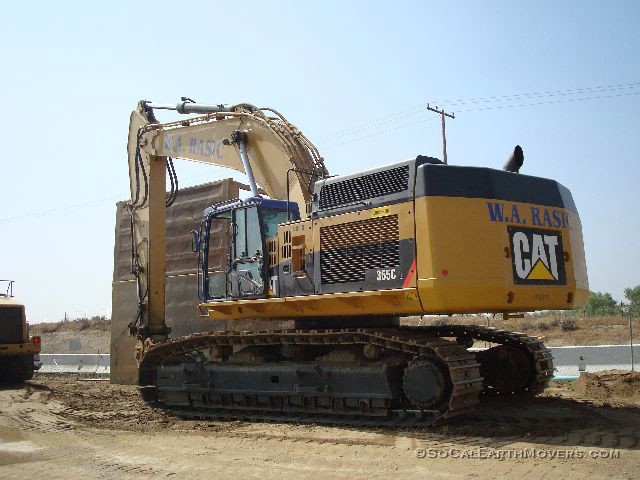 entire westbound side could be used for construction of the pipeline.
They had to install temporary traffic signals at all
intersections and road signs throughout the near 3 mile stretch. Wes
said all this should be returned back to its normal state and they will
be gone by years end.
entire westbound side could be used for construction of the pipeline.
They had to install temporary traffic signals at all
intersections and road signs throughout the near 3 mile stretch. Wes
said all this should be returned back to its normal state and they will
be gone by years end.
This project is proving to be a huge
mile stone for
W.A. RASIC and putting them in the books for heavy pipeline
contractors. For more information about the RASIC company visit their
website at www.WARASIC.com
. Construction of the South Reach portion of this pipeline should begin
within the next few months. This will take where the pipeline leaves
off at Cactus Street and parallel the 215 freeway all the way down to
Oleander Ave. completing the Perris Pipeline. W.A. RASIC was not the
winning bidder for this project and will be done by Texas based Oscar
Renda Contracting company according to the MWD website.
written
6/18/2008
by
©SoCalEarthMovers.com
|
|
|


 The tunnels will be one of the last things to
finish
up this pipeline. The above ground excavation is
nearing
completion and should be finished up by the end of the month
Brodeur said. Crews have worked 10 hour days and as
well as
every other Saturday throughout the pipelines construction,
and
lately even some nights. Last week crews closed a small
street
and worked throughout the night, two days in a row,
to put in a segment of pipe before morning.
The
MWD wants to have the pipe pressure tested and have
water
flowering by mid July. Because the MWD changed the
pipes
route and last minute and major amounts of unforeseen rock
was
hit, Brodeur says this is an unreal expectation
from
them. RASIC faces a $10,000 a day fine for each day
the
water is not flowing after the deadline.
The tunnels will be one of the last things to
finish
up this pipeline. The above ground excavation is
nearing
completion and should be finished up by the end of the month
Brodeur said. Crews have worked 10 hour days and as
well as
every other Saturday throughout the pipelines construction,
and
lately even some nights. Last week crews closed a small
street
and worked throughout the night, two days in a row,
to put in a segment of pipe before morning.
The
MWD wants to have the pipe pressure tested and have
water
flowering by mid July. Because the MWD changed the
pipes
route and last minute and major amounts of unforeseen rock
was
hit, Brodeur says this is an unreal expectation
from
them. RASIC faces a $10,000 a day fine for each day
the
water is not flowing after the deadline. entire westbound side could be used for construction of the pipeline.
They had to install temporary traffic signals at all
intersections and road signs throughout the near 3 mile stretch. Wes
said all this should be returned back to its normal state and they will
be gone by years end.
entire westbound side could be used for construction of the pipeline.
They had to install temporary traffic signals at all
intersections and road signs throughout the near 3 mile stretch. Wes
said all this should be returned back to its normal state and they will
be gone by years end. 





 The Project is known as the "North Reach
The Project is known as the "North Reach 



 trench shield. As the pipe progresses forward these
mammoth
boxes are dragged forward in the trench as well by the large
excavators. A total of 3 of the huge 45' stacked trench boxes
are
on site. (
trench shield. As the pipe progresses forward these
mammoth
boxes are dragged forward in the trench as well by the large
excavators. A total of 3 of the huge 45' stacked trench boxes
are
on site. ( 
 After each pipe has been put into the trench a special
backfill called "birdseye" is placed around the
pipe.
After the birdseye the trench is backfilled and
compacted
with screened earth. W.A. RASIC even has their own
screening facility on site. All the dirt dug from
the
trenches is loaded into dump trucks and hauled down
the street to
a large lot by the 215 freeway where it is screened
and then
reloaded into trucks to be used for backfill.
Wes said that
the soil they are screening here is so fine and
good for backfill
that they are actually selling it off to some of their
company's other
job sites. (
After each pipe has been put into the trench a special
backfill called "birdseye" is placed around the
pipe.
After the birdseye the trench is backfilled and
compacted
with screened earth. W.A. RASIC even has their own
screening facility on site. All the dirt dug from
the
trenches is loaded into dump trucks and hauled down
the street to
a large lot by the 215 freeway where it is screened
and then
reloaded into trucks to be used for backfill.
Wes said that
the soil they are screening here is so fine and
good for backfill
that they are actually selling it off to some of their
company's other
job sites. (


